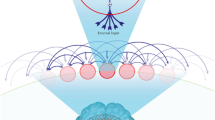Abstract
The human brain, with its intricate network of neurons and synapses, remains one of the most complex systems to understand and model. The study presents a groundbreaking approach to understanding complex neural networks by introducing a dynamic fitting method for hybrid time-delayed and uncertain internally-coupled complex networks. Specifically, the research focuses on integrating a Neural Mass Model (NMM) called Jansen-Rit Model (JRM) with the Kuramoto model, by utilizing real human brain structural data from Diffusion Tensor Imaging (DTI), as well as functional data from Electroencephalography (EEG) and Magnetic Resonance Imaging (MRI), the study extends above two models into a more comprehensive brain-like model. This innovative multimodal model enables the simultaneous observation of frequency variations, synchronization states, and simulated electrophysiological activities, even in the presence of internal coupling and time delays. A parallel fast heuristics algorithm serves as the global optimization method, facilitating rapid convergence to a stable state that closely approximates real human brain dynamics. The findings offer a robust computational tool for neuroscience research, with the potential to simulate and understand a wide array of neurological conditions and cognitive states. This research not only advances our understanding of complex neural dynamics but also opens up exciting possibilities for future interdisciplinary studies by further refine or expand upon the current model.
Access this chapter
Tax calculation will be finalised at checkout
Purchases are for personal use only
Similar content being viewed by others
References
Sporns, O.: Networks of the brain. MIT Press, Cambridge, Mass (2011)
Jirsa, V.K., Haken, H.: Field theory of electromagnetic brain activity. Phys. Rev. Lett. 77(5), 960–963 (1996)
Deco, G., Jirsa, V.K.m McIntosh, A.R.: Emerging concepts for the dynamical organization of resting-state activity in the brain. Nat. Rev. Neurosc. (2011)
David, O., Friston, K.J.: ‘A neural mass model for MEG/EEG. NeuroImage 20(3), 1743–1755 (2003)
Friston, K.J.: Modalities, modes, and models in functional neuroimaging. Science 326(5951), 399–403 (2009)
Breakspear, M.: Dynamic models of large-scale brain activity. Nat. Neurosci. 20(3), 340–352 (2017)
Fries, P.: A mechanism for cognitive dynamics: neuronal communication through neuronal coherence. Trends Cogn. Sci. 9(10), 474–480 (2005)
Fries, P.: Rhythms for Cognition: Communication through Coherence. Neuron 88(1), 220–235 (2015)
Canolty, R.T., Knight, R.T.: The functional role of cross-frequency coupling. Trends Cogn. Sci. 14(11), 506–515 (2010)
Kuramoto, Y.: Self-entrainment of a population of coupled non-linear oscillators. In: International Symposium on Mathematical Problems in Theoretical Physics, pp. 420–422. Springer, Berlin, Heidelberg (1975). https://doi.org/10.1007/BFb0013365
Strogatz, S.H.: From Kuramoto to Crawford: exploring the onset of synchronization in populations of coupled oscillators. Physica D 143(1–4), 1–20 (2000)
Cabral, J., Hugues, E., Sporns, O., Deco, G.: Role of local network oscillations in resting-state functional connectivity. Neuroimage 57(1), 130–139 (2011)
Deco, G., Jirsa, V. K., McIntosh, A.R.: Emerging concepts for the dynamical organization of resting-state activity in the brain. Nat. Rev. Neurosci. 12(1) (2011)
Cabral, J., et al.: Exploring mechanisms of spontaneous functional connectivity in MEG: How delayed network interactions lead to structured amplitude envelopes of band-pass filtered oscillations. Neuroimage 90, 423–435 (2014)
Tzourio-Mazoyer, N., et al.: Automated anatomical labeling of activations in spm using a macroscopic anatomical parcellation of the mni mri single-subject brain. Neuroimage 15(1), 273–289 (2002)
Behrens, T.E.J., et al.: Probabilistic diffusion tractography with multiple fibre orientations: What can we gain? Neuroimage 34(1), 144–155 (2007)
Wendling, F., et al.: Epileptic fast activity can be explained by a model of impaired GABAergic dendritic inhibition: Epileptic activity explained by dendritic dis-inhibition. Eur. J. Neurosci. 15(9), 1499–1508 (2002)
Sanchez-Todo, R. et al.: Personalization of hybrid brain models from neuroimaging and electrophysiology data (2018)
Spiegler, A., et al.: Selective activation of resting-state networks following focal stimulation in a connectome-based network model of the human brain. eNeuro (2016)
Jirsa, V.K., et al.: On the nature of seizure dynamics. Brain 137(8) (2014)
Rubin, J.E., Terman, D.: High frequency stimulation of the subthalamic nucleus eliminates pathological thalamic rhythmicity in a computational model. J. Comput. Neurosci. 16(3), 211–235 (2004)
Castellanos, F.X., Proal, E.: Large-scale brain systems in ADHD: beyond the prefrontal–striatal model. Trends Cogn. Sci. 16(1), 17–26 (2012)
Deco, G., Kringelbach, M.L.: Great expectations: using whole-brain computational connectomics for understanding neuropsychiatric disorders. Neuron 84(5) (2014) ‘
Bauer, L.G. et al.: Quantification of kuramoto coupling between intrinsic brain networks applied to fmri data in major depressive disorder. Front. Comput. Neurosci. 16 (2022)
Smith, S.M. et al.: Advances in functional and structural MR image analysis and implementation as FSL. NeuroImage 23, S208–S219 (2004). https://fsl.fmrib.ox.ac.uk/fsl/fslwiki
Author information
Authors and Affiliations
Corresponding author
Editor information
Editors and Affiliations
Rights and permissions
Copyright information
© 2024 The Author(s), under exclusive license to Springer Nature Switzerland AG
About this paper
Cite this paper
Jin, Z. (2024). A Dynamic Fitting Method for Hybrid Time-Delayed and Uncertain Internally-Coupled Complex Networks: From Kuramoto Model to Neural Mass Model. In: Cherifi, H., Rocha, L.M., Cherifi, C., Donduran, M. (eds) Complex Networks & Their Applications XII. COMPLEX NETWORKS 2023. Studies in Computational Intelligence, vol 1144. Springer, Cham. https://doi.org/10.1007/978-3-031-53503-1_3
Download citation
DOI: https://doi.org/10.1007/978-3-031-53503-1_3
Published:
Publisher Name: Springer, Cham
Print ISBN: 978-3-031-53502-4
Online ISBN: 978-3-031-53503-1
eBook Packages: EngineeringEngineering (R0)




